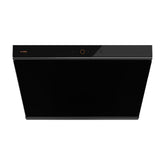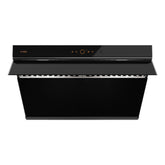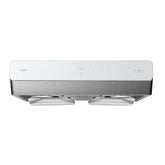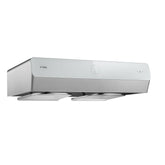Range Hood Maintenance Tips
Last Updated: 3/17/2023
Author: James Zhao, Sr. Tech Specialist & Alex Park, Product Specialist
If you enjoy cooking, you likely know the importance of having a range hood in your kitchen. Range hoods are essential for removing smoke, fumes, and other pollutants from the air and creating a clean and healthy cooking environment. To keep your range hood functioning properly, it's important to perform regular maintenance.
In this article, we'll provide some range hood maintenance tips to help keep your kitchen hood in top condition. We'll cover everything you need to know about range hood maintenance regarding:
- Cleaning or replacing filters
- Cleaning the exterior
- Checking the fan blades
- Inspecting the air ducts
- Getting professional servicing
In addition, we’ll answer some FAQs homeowners may have about upgrading their range hood or finding the right one for their kitchen.
To maintain your kitchen range hood, follow these five steps.

1. Clean or Replace Filters When Needed
By cleaning or replacing a range hood’s filter monthly (or as needed), you can help extend the life of your hood and prevent any potential problems that could compromise its performance. Whether you will need to clean or replace the filter will depend on the kind of range hood you have, particularly if you have a ducted or recirculation model.
Ducted Range Hood Filters
Most ducted range hoods have a mesh filter to catch grease and prevent the air expelled outside from being overly polluted. Mesh filters will not have to be replaced, but they should be cleaned around once a month to prevent buildup.
Here are the steps to clean range hood filters:
- Remove the filters: Most range hood filters can be easily removed by pushing or pulling on a tab or latch. Refer to the manufacturer's instructions for your specific model.
- Soak: Fill a sink or bucket with hot water and add a degreaser or mild dishwashing detergent. Place the filters in the water and let them soak for 10-15 minutes.
- Scrub: After soaking, use a soft brush or sponge to scrub the filters, paying special attention to areas with heavy grease and dirt buildup. Be gentle and avoid using abrasive materials that could damage the filters.
- Rinse: Rinse your filters thoroughly with hot water to remove any remaining grease and detergent. Make sure that all soap residue is removed.
- Dry: Shake off any excess water and leave the filters on a towel overnight to completely dry before reattaching them to the range hood.
Recirculation Filters
If you have a non-ducted range hood that recirculates the air (known as a recirculation model), they will most likely have a replaceable charcoal filter. Charcoal filters will need to be discarded and replaced once a month, or whenever you notice unpleasant odors or decreased airflow in your kitchen.
A recirculation range hood filter cleans the air before pushing it back into your home, meaning it will acquire buildup faster than ducted filters. Follow your range hood’s manual to remove and replace the dirty filter. Most disposable filters can be purchased online from the manufacturer or at your local hardware store.
2. Clean the Range Hood’s Exterior
It is important to wipe down the exterior of a range hood weekly to maintain its appearance and functionality. Over time, grease, smoke, and dust can accumulate on the surface of the range hood, making it look dirty and dull. Wiping down the exterior removes this buildup, helping to restore the range hood’s original appearance and prevent any damage to the finish.
Regularly cleaning the exterior of your range hood also helps prevent the buildup of grease and other debris, ensuring that the ventilation system is functioning properly and that the air in your kitchen is clean and healthy.
To properly clean the exterior of your range hood, follow these steps:
- Turn off the range hood: Turn off and unplug your range hood to avoid the risk of electric shock.
- Prepare a cleaning solution: Mix a small amount of mild dish soap or a non-abrasive cleaner with warm water in a bowl.
- Wipe down the exterior: Dip a sponge into the cleaning solution and wring out any excess water. Gently wipe down the exterior of the range hood, starting from the top and working your way down.
- Clean the knobs and buttons: Use a damp cloth or a cotton swab to clean knobs, buttons, and other small areas that may be hard to reach.
- Rinse with clean water: Use a clean, damp cloth to wipe away any soap residue. Rinse the cloth frequently in clean water to avoid spreading the dirt around.
- Dry the exterior: Use a dry cloth or paper towel to remove any excess water and prevent streaks or water spots.
- Polish (optional): Depending on the finish of your range hood, wipe down the exterior with a small amount of stainless steel polish on a clean cloth to give it a shiny finish.
3. Check the Fan Blades
Check the fan blades of your range hood around every six months to ensure that they are functioning properly. Fan blades play a crucial role in the performance of a range hood, as the blades are responsible for drawing in air and removing smoke, fumes, and other particles from your kitchen. If the fan blades are dirty or damaged, they can affect the performance of the range hood.
Depending on the design of your range hood, you may need to remove the filter or cover to access the fan. Once you unplug your range hood and remove any hardware, inspect the fan for buildup or damage. Wipe the fan clean of any dust or grease using a microfiber cloth, but avoid using any liquid cleaners that could damage the range hood’s internal electrical system.
Once you’ve cleaned the fan and reinstalled the filters or cover, test your range hood by turning it back on. If you notice any cracks or bends in your fan, call a qualified professional for repairs.
4. Inspect the Air Ducts
If you have a ducted (or vented) range hood, it is important to inspect your air ducts at least once a year to ensure that they are clean and functioning properly. The air ducts play a crucial role in the performance of the range hood, as they are responsible for carrying the air and pollutants out of your kitchen and venting them outside.
While filters should remove some contaminants from entering your air ducts, the ducts will still accumulate grease and dust over time. Since they are vented to the outside, air ducts also run the risk of pollen or other outside debris entering them.
If your air ducts are wall-mounted, you may be able to easily access them by unscrewing your vent cover (look at your owner’s manual for instructions based on your model). Inspect the ducts using a flashlight to look for any signs of damage or debris, including cracks, holes, dust, or grease. To remove buildup and improve the functionality of your ducts, use a cloth or vacuum cleaner hose to clean hard-to-reach places.
If you cannot easily access your air ducts or have noticed they are damaged, call a qualified appliance technician to handle the necessary cleanup or repairs.
5. Get Professional Servicing As Needed
As a general guideline, it is recommended to have your range hood professionally serviced at least once every 1-2 years. The exact frequency at which you should professionally service a range hood depends on several factors, such as how often you cook, the type of cooking you do, and the type of range hood you have.
To get professional servicing for your range hood, follow these steps:
- Check your warranty: If your range hood is still under warranty, check the terms and conditions to see if servicing is covered.
- Contact the manufacturer: If your range hood is no longer under warranty, contact the manufacturer to find out if they offer servicing or if they can recommend a qualified technician in your area.
- Look for local appliance repair: Search for local appliance repair services online that specialize in range hood repair and servicing. Be sure to check reviews and ratings to hire a reliable and experienced technician.
- Get quotes: Contact several technicians to get quotes for the servicing you need. Compare prices and services to find the best option for you.
- Schedule the servicing: Once you have found a qualified technician, schedule the servicing at a convenient time for you. Be sure to follow any instructions or guidelines they provide for preparing your range hood for servicing.
Professional servicing can help identify any issues with your range hood early on, such as clogs, damaged parts, or malfunctions that could affect its performance. By addressing these issues, you can help extend the life of your range hood and prevent any potential problems.
Overall, regularly inspecting, cleaning, and servicing your range hood is an important part of maintaining a clean and healthy kitchen environment. By ensuring that your range hood is working efficiently, you can enjoy a safer, more comfortable cooking experience and protect your health and your home.
Related FAQs
If you’re interested in range hood maintenance, chances are you already have a range hood in your kitchen. (If not, here’s our guide to help you choose a range hood.) In addition to questions about maintenance, we at FOTILE field a lot of general range hood FAQs. Here are some common questions we hear from current range hood owners.
Is my range hood the right size?
To determine what size range hood is right for you, you need to consider the size of your cooktop or range, as well as the size of your kitchen. If you’ve noticed that your range hood isn’t running optimally even after you’ve performed maintenance, the previous property owner or landlord may have installed the wrong size.
Here are some guidelines to help you determine if your range hood is the right size:
- Measure the size of your cooktop or range: Measure the width of your cooktop or stove range to determine the minimum size range hood you need. As a general rule, your range hood should be at least as wide as your cooktop or range, and preferably a few inches wider.
- Consider the size of your kitchen: The size of your kitchen will also play a role in determining the right size range hood. For example, if you have a small kitchen, you may need a smaller range hood that is less powerful, while if you have a large kitchen, you may need a larger range hood that can handle a higher volume of air.
- Determine the appropriate CFM rating: CFM (cubic feet per minute) is a measure of the volume of air that a range hood can move. As a general rule, your range hood should have a CFM rating that is at least half the number of square feet in your kitchen. For example, if your kitchen is 200 square feet, you would need a range hood with a CFM rating of at least 100.
- Check the manufacturer's guidelines: The manufacturer's guidelines for your range hood should provide information on the size and CFM rating for your specific model. Consult these guidelines to ensure that your range hood is the right size for your kitchen.
Overall, the right size range hood should be able to effectively capture and remove smoke, fumes, and other pollutants from your kitchen.
Do I need a new range hood?
Most issues with range hoods can be resolved with regular maintenance or repairs. However, if you’ve consulted an appliance technician and they cannot easily correct your problem, it may be worth it to invest in a new range hood.
Here are some signs that you may need a new range hood:
- Decreased airflow: If your range hood is not providing as much airflow as it used to, even after cleaning and maintenance, it may be time to replace it.
- Unpleasant odors: If you smell unpleasant cooking odors in your kitchen when the range hood is turned on, it may not be functioning properly and might need to be replaced.
- Excessive noise: If you notice that your range hood is making more noise than usual, this may be an indication that the fan or other components are worn out. You may be able to buy individual parts to repair the range hood, rather than replacing the entire unit.
- Wear and tear: If your hood is visibly damaged or shows signs of wear and tear, such as cracks, rust, or discoloration, it may be time to replace it.
- Age: If your range hood is more than 10 years old, it may be nearing the end of its lifespan and may need to be replaced.
- Inefficient performance: If your range hood is not removing smoke, fumes, and other pollutants from your kitchen effectively, or if it is using more energy than usual, it may be time to replace it with a newer, more efficient model.
If you notice any of these signs, it may be time to consider replacing your range hood with a newer model. A more modern range hood can improve the air quality in your kitchen, reduce the risk of grease fire, and provide a more comfortable cooking experience.
How often should I upgrade my range hood?
It's a good idea to consider upgrading your range hood every 10 years or so, or sooner if you notice any signs of decreased performance or wear and tear. By upgrading your range hood, you can enjoy a safer, more comfortable cooking experience, and help protect your health and your home.
Upgrading your range hood can provide several benefits, including:
- Improved air quality: A newer range hood can remove smoke, fumes, and other pollutants from your kitchen more effectively, improving the air quality in your home and reducing the risk of respiratory problems and other health issues.
- Better performance: A newer range hood can operate more efficiently, using less energy and reducing your utility bills.
- More features: Newer range hoods often come with additional features, such as multiple fan speeds, built-in lights, and automatic shut-off, which can improve your cooking experience and provide greater convenience.
- Enhanced safety: Newer range hoods often come with advanced safety features, such as automatic shut-off in case of a fire, which can help protect your home and family.
Related Articles
If you’re curious about range hood maintenance, here are related articles that you may be interested in:
About FOTILE Range Hoods
FOTILE America is a leading provider of kitchen ventilation technologies. We carry under-cabinet, wall-mounted, and island range hoods, as well as ducted and recirculation models featuring advanced technologies for performance and convenience. To learn more, shop our range hood models today.
- Choosing a selection results in a full page refresh.






